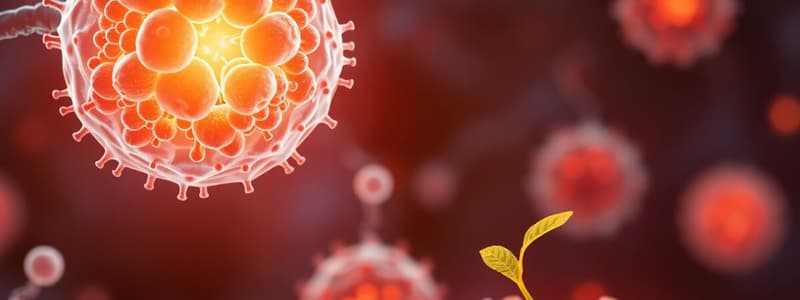Podcast
Questions and Answers
During cellular respiration, what is the primary role of the oxygen you breathe in?
During cellular respiration, what is the primary role of the oxygen you breathe in?
- To directly produce ATP molecules
- To act as the final electron acceptor in the electron transport chain (correct)
- To break down glucose into pyruvate
- To remove carbon dioxide from the body
Cellular respiration and breathing are the same process.
Cellular respiration and breathing are the same process.
False (B)
What are the three main stages of cellular respiration?
What are the three main stages of cellular respiration?
Glycolysis, Pyruvate Oxidation and the Citric Acid Cycle, Oxidative Phosphorylation
In cellular respiration, glucose is ______ to carbon dioxide, while oxygen is ______ to water.
In cellular respiration, glucose is ______ to carbon dioxide, while oxygen is ______ to water.
Match the following processes with their locations within the cell:
Match the following processes with their locations within the cell:
What is the role of dehydrogenase in cellular respiration?
What is the role of dehydrogenase in cellular respiration?
Most of the ATP molecules produced during cellular respiration are generated during glycolysis.
Most of the ATP molecules produced during cellular respiration are generated during glycolysis.
What is the net molecular product of glycolysis, per glucose molecule?
What is the net molecular product of glycolysis, per glucose molecule?
The process by which cells produce ATP without oxygen is called ______.
The process by which cells produce ATP without oxygen is called ______.
If a yeast cell is moved from an aerobic to an anaerobic environment, what change must occur to maintain the same rate of ATP production?
If a yeast cell is moved from an aerobic to an anaerobic environment, what change must occur to maintain the same rate of ATP production?
Flashcards
How do cells get energy?
How do cells get energy?
Cells get energy to function through food, photosynthesis, and cellular respiration.
Cellular Respiration
Cellular Respiration
The process where atoms of carbon dioxide and water are rearranged to produce sugar and oxygen.
Breathing's role in cellular respiration
Breathing's role in cellular respiration
Breathing provides oxygen for use in cellular respiration and removes carbon dioxide.
Exergonic Reaction
Exergonic Reaction
Signup and view all the flashcards
Endergonic Reaction
Endergonic Reaction
Signup and view all the flashcards
Cellular Energy Capture
Cellular Energy Capture
Signup and view all the flashcards
Oxidation
Oxidation
Signup and view all the flashcards
Reduction
Reduction
Signup and view all the flashcards
Redox Reaction
Redox Reaction
Signup and view all the flashcards
Glycolysis
Glycolysis
Signup and view all the flashcards
Study Notes
- Cells get energy to function through food.
- Photosynthesis and cellular respiration provide energy for life.
- The ultimate energy source comes from the sun.
Cellular Respiration
- Glucose is the beginning point.
- Atoms of carbon dioxide and water are rearranged and sugar and oxygen are produced.
- Sugar is broken down into carbon dioxide and water, and the cell captures some of the released energy and makes ATP.
- Breathing supplies O2 for use and removes C02
- Breathing is purely a gas exchange.
- Cellular respiration is the aerobic (oxygen-requiring) harvesting of energy from food molecules by cells.
- Breathing provides oxygen for ATP and removes carbon dioxide when breathing out.
- During, you breathe in oxygen or O2, it goes through your lungs, it is transported into your bloodstream, and then the muscle cells carry out cellular respiration, Cho6 O2 -> CO2 H2O ATP, after that the Co2 is transported back up through your bloodstream, back through your lungs, and then out as carbon dioxide.
- Banks energy from ATP molecules.
- An exergonic reaction releases energy, it transfers energy from glucose to form ATP.
- Produces up to 32 ATP molecules for each glucose molecule.
- Uses about 34% of the energy originally stored in glucose with the rest of the energy lost as heat.
- Your body requires a continuous supply of energy cellular respiration provides energy for body maintenance and voluntary activities.
- Hundreds & thousands of molecules of ATP are needed to survive every day.
Photosynthesis
- Chloroplasts capture some of the energy in sunlight.
- An endergonic reaction, takes in sunlight.
Key Concepts
- A balance of energy intake and expenditure is required to maintain a healthy weight.
- Cells capture energy by transferring electrons from food to oxygen producing ATP.
- Cells extract energy from food molecules using the transfer of electrons in a chemical reaction.
- When food molecules like glucose are broken down, electrons are removed in a process called oxidation. These electrons are then transferred to NAD+ a coenzyme that gets reduced to NADH, which temporarily stores energy for later use in ATP production.
- NADH passes electrons to an electron transport chain. Energy is released as electrons "fall” from carrier to carrier and finally to 02.
- Oxidation is the loss of electrons in a reaction.
- Reduction is the gain of electrons in a reaction.
- Oxidation-reduction ( redox) reactions work together. When one element loses electrons, its coupled element gains those electrons.
- Glucose (C6H12O6) is oxidized (loses hydrogen atoms and electrons) to form carbon dioxide (CO2).
- Oxygen is reduced (gains hydrogen atoms and electrons) to form water (H2O). The energy released from this process is used to produce ATP, which powers cellular activities. Some energy is also lost as heat.
- Glucose undergoes oxidation, and oxygen undergoes reduction which drives ATP synthesis through cellular respiration - a redox reaction
- Oxidation of organic fuel is an organic flue molecule like glucose or another nutrient that loses hydrogen atoms (electrons and protons) becoming oxidized.
- Oxidation is facilitated by an enzyme called dehydrogenase.
- When hydrogen atoms split the two hydrogen atoms released are split into protons (H+) and electrons (e-).
- Reduction of NAD+ to NADH is when the electrons are transferred to NAD+ reducing it to NADH one proton (H+) is released as a free ion.
- The electron transport chain is a crucial step in cellular respiration where ATP is produced.
- NADH ( an electron carrier ) transfers two electrons (2e-) to the electron transport chain, and NADH is oxidized back to NAD+ which can be reused in earlier steps of respiration - NADH donates electrons
- Next electrons move through a series of proteins embedded in the inner mitochondrial membrane. As electrons move down the chain, energy is gradually released which is used to pump protons (H+) across the membrane, creating a proton gradient.
- ATP synthesis is the controlled release of energy drives ATP synthesis, which powers cellular activities.
- Oxygen is the final electron acceptor, at the end of the chain, electrons combine with oxygen (02) and protons (H+) to form water (H2O) this step is essential for maintaining the electron flow, ensuring continued ATP production - the final step of the Electron Transport chain
- If 1 thing is losing electrons something else must give them.
- Organic fuel is anything you intake into your body.
- Dehydrogenase is an enzyme that takes the hydrogens off of the glucose.
Stages of Cellular Respiration
- Occurs in three main stages
- Glycolysis occurs in the cytosol, begins, and breaks down glucose into two molecules of a three-carbon compound called pyruvate.
- Pyruvate oxidation and the citric acid cycle takes place in the mitochondria, during pyruvate is oxidized to a two-carbon compound and supplies the third stage with electrons.
- Oxidative phosphorylation involves electron transport and chemiosmosis.
- NADH and a related electron carrier, FADH2 shuttle electrons to electron transport chains embedded in the inner mitochondrial membrane.
- Most of the ATP produced is generated by oxidative phosphorylation the electrons are finally passed to oxygen, which becomes reduced to H2O.
- The stage that does not take place in the mitochondria is glycolysis, it takes place in the cytosol.
- Glycolysis harvests chemical energy by oxidizing glucose to pyruvate.
- A glucose molecule is split in two, and these three-carbon intermediates which is produced in glycolysis) are oxidized to two molecules of pyruvate, yielding a net of 2 ATP and 2 NADH.
- Glycolysis splits glucose into two three-carbon intermediates, which are oxidized to pyruvate, producing 2 ATP and 2 NADH.
- ATP is formed by substrate-level phosphorylation in which a phosphate group is transferred from an organic molecule to ADP.
- net products are 2 ATP, 2 NADH, and 2 pyruvates for each glucose molecule produced
- After glycolysis, pyruvate (C3H4O3) is transported into the mitochondria and oxidized to form acetyl-CoA, releasing CO2 and producing NADH.
- Acetyl-CoA enters the cycle, where it undergoes further oxidation, breaking down completely into CO2 while generating NADH, FADH2, and ATP.
- The electrons stored in NADH and FADH2 will later be used in the electron transport chain to produce more ATP.
- Most ATP production occurs by oxidative phosphorylation which is the final stage of cellular respiration, where most of the cells' ATP is produced it occurs in the mitochondrial inner membrane and consists of two key processes, electron transport chain, and chemiosmosis and ATP synthesis.
- Substrate-level phosphorylation and oxidative phosphorylation produce up to 32 ATP molecules in every glucose molecule oxidized in cellular respiration.
- Fermentation enables cells to produce ATP without oxygen.
- Fermentation makes chemical energy without oxygen under anaerobic conditions muscle cells, yeast, and certain bacteria produce ATP by glycolysis.
- NAD+ is made for NADH and pyruvate is reduced to lactate (lactic acid fermentation) or alcohol and CO2 (alcohol fermentation)
- In an anaerobic environment, the yeast cell must consume glucose 15-16 times faster to compensate for the lower ATP yield from fermentqation compared to aerobic respiration - for the cell to continue generating ATP at the same rate, how out its rate of glucose consumption need to change?
Studying That Suits You
Use AI to generate personalized quizzes and flashcards to suit your learning preferences.




